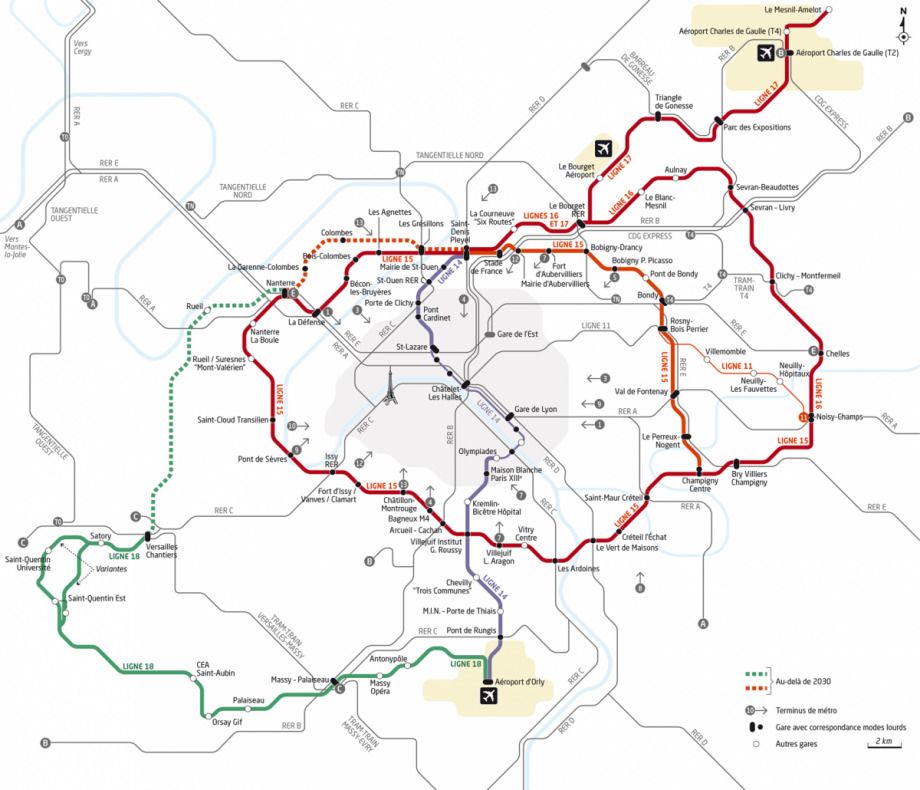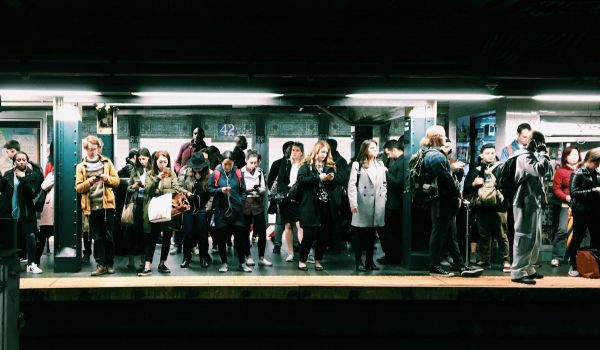Grand Paris Express Takes Its First Steps
With Europe’s previous transit-building wunderkind, Spain, plunged deep into economic crisis, Paris picked up the tunneling torch with a €22.6 billion plan to circle the city with two belts of driverless metros. But the expansion begins with a more traditional radial line, the 14, which currently runs from Olympiades, the Parisian Chinatown, northwest to Gare Saint-Lazare, one of the city’s three main railway stations. The plan is to extend the line, the newest in Paris, farther north to relieve congestion on the 13, connecting to both of its branches. A recent financing agreement helped bolster the first phase of the 14 extension: The 5.8-kilometer, four-station project will cost €1.38 billion, or $1.9 billion.
Paris also saw steps taken on a number of other extensions. The 1 line (the oldest and busiest in the system, and the oldest subway line to ever go driverless) will get a three-station eastward extension, and the 4 (the second busiest line) will get two new stops to the south. A few tramway projects have also moved forward.
This first phase of the 14 line extension is scheduled to be completed in 2017, but it’s just a small part of the larger Grand Paris Express project. Begun by former president Nicholas Sarkozy, the plan is to have 205 kilometers (126 miles) of driverless metros with 72 stations, mostly through the inner suburbs of Paris. The neighborhoods run the gamut, from poor banlieues like Clichy-sous-Bois to the sky-scraping edge city of La Défense. (Correction: I accidentally linked to an article from 2012 saying the total cost of the network had risen from its original €20.5 billion to €30 billion. Since then, it’s been brought back down to €22.6 billion, or $31.1 billion.)
Third World Transit Ain’t Cheap
When it comes to transit construction costs, your intuition — surely a dimly lit station in D.C. is more economical than a marble-faced one in South Korea? — is usually wrong. So it goes with third-world transit: Dhaka, the capital of Bangladesh and one of the world’s most congested cities, is spending $2.8 billion (“Tk 21,985 crore”) on a 20-kilometer elevated metro line. The Japan International Cooperation Agency is lending the money for the project at near-zero interest rates. Nippon Koei, a Japanese engineering consultancy that focuses on international projects, will build the line.
The $140-per-kilometer cost of the elevated line is not that much cheaper than the Silver Line project in Northern Virginia, which will extend the Washington Metro out to Dulles International Airport and Tysons Corner, Va. The Silver Line, mostly elevated but with a portion underground, costs $6.8 billion for 45 kilometers (28 miles), or $150 million per kilometer. Outside of Vancouver, the elevated Evergreen Line costs around $100 million per kilometer. The Dhaka project is in a more constrained urban environment compared to the Silver and Evergreen lines’ suburban settings, but it’s worth noting that for the price of these projects, some first world cities — among them Seoul, Helsinki and Lucerne, Switzerland — can build full-blown subways, which are more difficult from a technical standpoint than elevated lines.
SEPTA Doubles Up on Maintenance
The doomsday threats worked, and SEPTA got its funding. The Philadelphia area transit agency will double its $300 million annual capital spending to $600 million by 2018, to overcome a $5 billion maintenance backlog. Most of this will involve catching up, though riders may notice two things: New cars to replace the 43-year-old Silverliner IVs on regional rail lines, and a $40-50 million makeover for the 3.5 miles of pedestrian concourses the agency now owns between 8th and 18th streets.
Work Resumes on the Cincinnati Streetcar
The embattled Cincinnati streetcar is back on, as construction resumed last week after a six-week pause. With unnamed private donors paying $900,000 a year out of the $3.5 million operating cost — face-saving at best for anti-streetcar Mayor John Cranley — the short, mixed-traffic line to the Over-the-Rhine neighborhood is set to open in September 2016.
The Works is made possible with the support of the Surdna Foundation.
Stephen J. Smith is a reporter based in New York. He has written about transportation, infrastructure and real estate for a variety of publications including New York Yimby, where he is currently an editor, Next City, City Lab and the New York Observer.

















